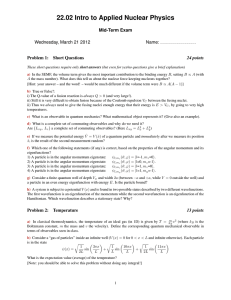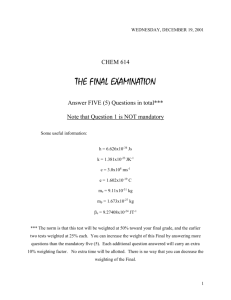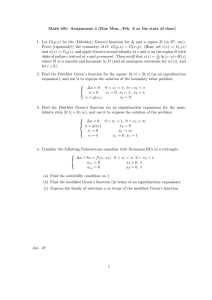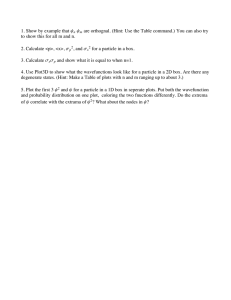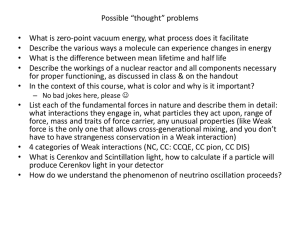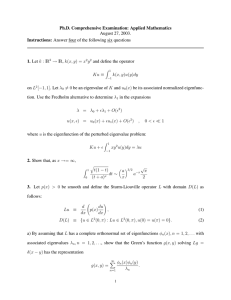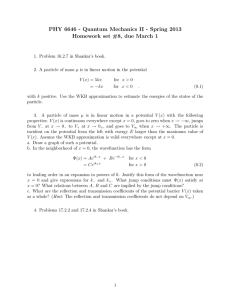22.02 Intro to Applied Nuclear Physics Mid-Term Exam Solution Problem 1:
advertisement
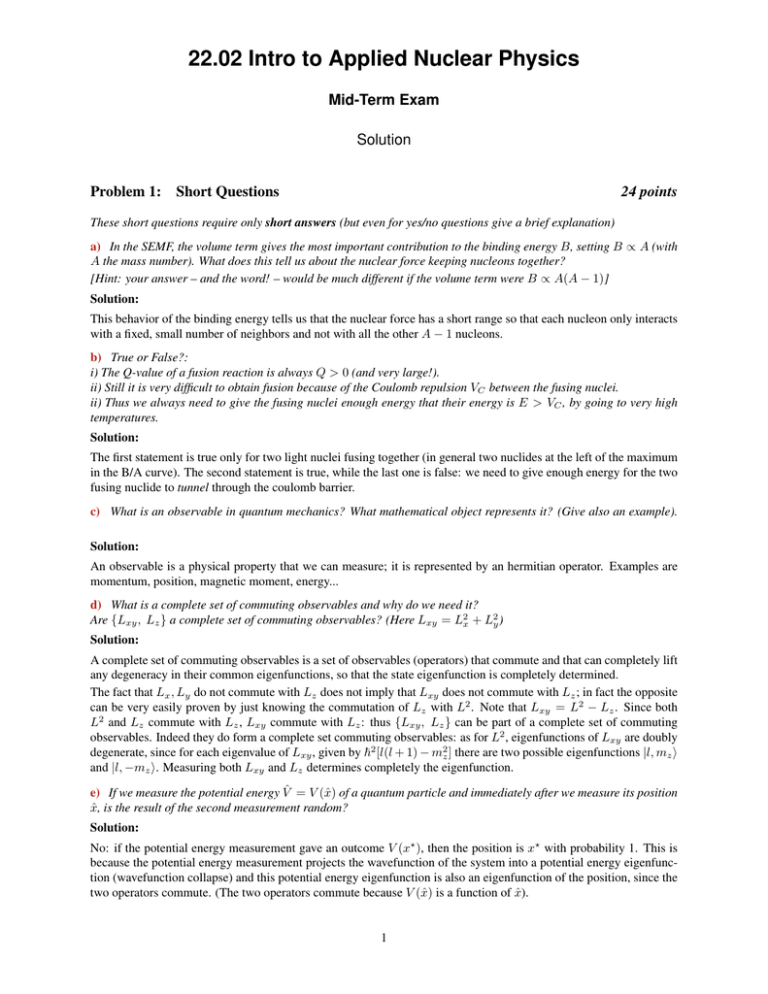
22.02 Intro to Applied Nuclear Physics
Mid-Term Exam
Solution
Problem 1:
Short Questions
24 points
These short questions require only short answers (but even for yes/no questions give a brief explanation)
a) In the SEMF, the volume term gives the most important contribution to the binding energy B, setting B ∝ A (with
A the mass number). What does this tell us about the nuclear force keeping nucleons together?
[Hint: your answer – and the word! – would be much different if the volume term were B ∝ A(A − 1)]
Solution:
This behavior of the binding energy tells us that the nuclear force has a short range so that each nucleon only interacts
with a fixed, small number of neighbors and not with all the other A − 1 nucleons.
b) True or False?:
i) The Q-value of a fusion reaction is always Q > 0 (and very large!).
ii) Still it is very difficult to obtain fusion because of the Coulomb repulsion VC between the fusing nuclei.
ii) Thus we always need to give the fusing nuclei enough energy that their energy is E > VC , by going to very high
temperatures.
Solution:
The first statement is true only for two light nuclei fusing together (in general two nuclides at the left of the maximum
in the B/A curve). The second statement is true, while the last one is false: we need to give enough energy for the two
fusing nuclide to tunnel through the coulomb barrier.
c) What is an observable in quantum mechanics? What mathematical object represents it? (Give also an example).
Solution:
An observable is a physical property that we can measure; it is represented by an hermitian operator. Examples are
momentum, position, magnetic moment, energy...
d) What is a complete set of commuting observables and why do we need it?
Are {Lxy , Lz } a complete set of commuting observables? (Here Lxy = L2x + L2y )
Solution:
A complete set of commuting observables is a set of observables (operators) that commute and that can completely lift
any degeneracy in their common eigenfunctions, so that the state eigenfunction is completely determined.
The fact that Lx , Ly do not commute with Lz does not imply that Lxy does not commute with Lz ; in fact the opposite
can be very easily proven by just knowing the commutation of Lz with L2 . Note that Lxy = L2 − Lz . Since both
L2 and Lz commute with Lz , Lxy commute with Lz : thus {Lxy , Lz } can be part of a complete set of commuting
observables. Indeed they do form a complete set commuting observables: as for L2 , eigenfunctions of Lxy are doubly
degenerate, since for each eigenvalue of Lxy , given by ~2 [l(l + 1) − mz2 ] there are two possible eigenfunctions |l, mz i
and |l, −mz i. Measuring both Lxy and Lz determines completely the eigenfunction.
e) If we measure the potential energy V̂ = V (x̂) of a quantum particle and immediately after we measure its position
x̂, is the result of the second measurement random?
Solution:
No: if the potential energy measurement gave an outcome V (x? ), then the position is x? with probability 1. This is
because the potential energy measurement projects the wavefunction of the system into a potential energy eigenfunction (wavefunction collapse) and this potential energy eigenfunction is also an eigenfunction of the position, since the
two operators commute. (The two operators commute because V (x̂) is a function of x̂).
1
f) Which one of the following statements (if any) is correct, based on the properties of the angular momentum and its
eigenfunctions?
1) A particle is in the angular momentum eigenstate:
ψl,mz (ϑ, ϕ) = |l=-1, mz =0i.
2) A particle is in the angular momentum eigenstate:
ψl,mz (ϑ, ϕ) = |l=0, mz =-1i.
3) A particle is in the angular momentum eigenstate:
ψl,mz (ϑ, ϕ) = |l=1, mz =0i.
4) A particle is in the angular momentum eigenstate:
ψl,my (ϑ, ϕ) = |l=1, my =-1i.
Solution:
Wrong (l is always a non-negative integer). Wrong (−l < mz < l in integer steps). Correct, Correct: both these last
two states respect all the requirements for l and |m| ≤ l, both integers.
g) Consider a finite quantum well of depth Vw and width 2a (between −a and +a, while V = 0 outside the well) and
a particle in an even energy eigenfunction with energy E. Is the particle bound?
Solution:
Since the solution is an even solution, we can get a bound state for any value of a and Vw . However, we have a bound
state only if E < 0. If E > 0 the particle is just scattering above the well. Note also that if E < Vw we don’t have a
solution at all.
h) A system is subject to a potential V (x) and is found in two possible states described by two different wavefunctions.
The first wavefunction is an eigenfunction of the momentum while the second wavefunction is an eigenfunction of the
Hamiltonian. Which wavefunction describes a stationary state? Why?
Solution:
The energy eigenfunction because it is a solution of the time-independent Schrödinger equation. Do not confuse the
momentum eigenfunction with the momentum itself: the momentum is an operator. In the description of QM we have
until now, operators do not evolve in time (although their expectation value and measurement outcomes do, since they
also depend on the system state which does depend on time). Thus, although the momentum operator is not evolving
in time, its eigenfunctions do evolve and are not stationary states.
Problem 2:
Temperature
13 points
a) In classical thermodynamics, the temperature of an ideal gas (in 1D) is given by T = kmB v 2 (where kB is the
Boltzmann constant, m the mass and v the velocity). Define the corresponding quantum mechanical observable in
terms of observables seen in class.
Solution:
T =
1
2
mkb (mv)
=
1
2
mkb p .
Transforming p into the QM operator, we have
~2 d 2
Tˆ = −
mkb d x2
b) Consider a “gas of particles” inside an infinite well (V (x) = 0 for 0 < x < L and infinite otherwise). Each
particle is in the state
r
r
r
1
3πx
1
10π x
1
11πx
ψ(x) =
sin
+
sin
+
sin
2L
L
L
L
2L
L
What is the expectation value (average) of the temperature?
[Note: you should be able to solve this problem without doing any integral!]
Solution:
q
q
2
We recognize the eigenfunctions of the Hamiltonian ϕn (x) = L2 sin nπx
:
note
the
factor
L
L which makes sure
the eigenfunction is correctly normalized. If you did not remember this, you should at least considered that the sum of
proabilities for the 3 states should have given you 1.
Thus the state can be written:
1
1
1
ψ(x) = ϕ3 + √ ϕ10 + ϕ11
2
2
2
2
These are also eigenfunctions of the temperature (inside the well) since the temperature and the Hamiltonian (equal to
the kinetic energy in the well) commute. The corresponding temperature eigenvalues are
Tn =
2
~2 k 2
~2 π 2 2
En =
= 2
n .
kb
mkb
L mkb
The average temperature is then:
hT i =
X
n
Tn Pn =
X
n
~2 π 2
Tn |cn | = 2
L mkb
Some of you have started from Tˆ =
2
1
2
mkb p̂
1 2 1 2 1 2
3 + 10 + 11
4
2
4
D E
and calculated Tˆ =
1
mkb
=
~2 π 2
~2 π 2
165
=
82.5
2L2 mkb
L2 mkb
2
hp̂i : this is wrong since in general p2 6=
2
hpi (also for any other observable and any random variable).
Problem 3:
Scattering
12 points
A source of neutrons produces a flux of neutrons of intensity Φinc and energy E. To protect the worker, in front of
the source a wall of thickness L has been built, which we can model with a potential barrier V > E. To monitor her
health, the worker wears a detector that measure the neutron flux.
a) Sketch a simple drawing showing how you model this problem (assume we leave in a 1D world!). Show in the
sketch the characteristics of the wavefunction describing the neutron.
Solution:
Note: this problem does not describe how neutron shielding does work in practice. We will see that neutrons undergo
many scattering events in the material, being slow down in the wall.
For the problem at hand, the situation is describe by a traveling wave before and after the wall (with same wavelength
λ but different amplitude) and a decaying exponential in the wall.
Figure 1: Sketch of neutron shielding
b) What is the flux of neutrons measured by the detector? Assume a simple model for the tunneling, in the limit
where the tunneling probability is small: this means that you do not need to solve completely the problem to find the
–approximate– answer.
Solution:
The detector
measures the transmitted flux. In the limit of small tunneling, we can write Φt ≈ 4e−2κL Φinc , with
q
κ = 2m(V~2−H) .
Problem 4:
Spontaneous Fission
30 points
2
e
1
Useful quantities: ~c = 197MeV fm; ~c
= 137
; c = 3 × 108 m/s; R0 = 1.25fm.
A note about this problem: Because of the small and large quantities involved, small rounding errors give very
different results. This is ok in the Midterm, but if you want to calculate something like this in real life, make sure you
pay attention to numerical errors.
Also, although the final answer does give you an idea about the fact that Cm can indeed undergo spontaneous fission,
estimating the fission rate in this way is a bad approximation, since we expect Cm to fission not in just these two
fragments but to lead to a distribution of possible pairs of fragment, all accompanied by the release of some neutrons.
This would be a 3 (or larger) body problem, which complicates estimates.
3
a) Consider the isotope Curium-250 (250
96 Cm), with mass 232.938 GeV. Given its A and Z numbers, do you expect this
isotope to be stable?
Solution:
The ratio of the mass and proton number is Z/A ≈ 0.384. We know that for heavy stable nuclei this ratio is instead
≈ 0.41 (Z ≈ A/2 only for light nuclides). Thus we expect this isotope to be unstable and to decay by a process that
will make it shed some neutrons or acquire smaller A.
Curium-250 is the lightest nuclide to undergo spontaneous fission as the main decay mode. We want to analyze this
decay mode following the same theory we saw for alpha decay and in particular estimate the half-life of 250 Cm. The
following questions will guide you through the estimation.
b) Assume that the spontaneous fission leads to the decay:
250
96 Cm
→
130
52 Te78
+120
44 Ru76
What is the Q-value for the reaction? How does this compare to the usual Q-value for typical alpha decay?
250
120
[The mass of 96
Cm is 232.938GeV, the mass of 130
52 Te78 is 121.002 GeV and the mass of 44 Ru76 is 111.724GeV]
Solution:
The Q-value can be calculated from the mass differences:
Q = mCm − mN d − mKr = 0.212GeV = 212M eV
Typical alpha decay release a few MeV of energy, so the Q value here is much larger.
c) What is the Coulomb potential VC (R) = Q1RQ2 at the distance R = RT e + RRu , where RX is the nuclear radius?
What is the distance Rc at which the Coulomb potential is equal to the Q-value?
Solution:
The nuclear radius is RA = 1.25A1/3 fm, thus we have:
RRu = 1.25f m × 1201/3 = 6.17f m
RT e = 1.25f m × 1301/3 = 6.33f m
yielding R = 12.50fm.
The Coulomb potential is given by
VC (R) =
1
44 × 52
e2 ZN d ZKr
e2 ZN d ZKr
= ~c
=
197MeV fm
= 263.20MeV
R
~c
R
137
12.50fm
2
1
was given in cgs units, the Coulomb potential could be calculated from it in
Note: because the fine constant ~e c = 137
cgs units.
To find the distance Rc we equate the Coulomb potential to the Q-value:
e2 Z1 Z2
=Q
Rc
→
RC =
e2 Z 1 Z 2
VC (R)
263.20
=R
= 12.50fm ×
= 15.52fm
Q
Q
212
d) We want to estimate the probability of tunneling for an effective particle in the center of mass frame of the Tellurium
and Ruthenium nuclei (with reduced mass µ).
To estimate the tunneling probability we replace the Coulomb barrier with a rectangular barrier of height VH =
VC (R) and length L = (Rc − R). What is the tunneling probability?
Solution:
The reduced mass is
µ=
m1 m2
121.002 × 111.724
=
= 58.089GeV
m1 + m2
111.724 + 121.002
Since we want to estimate the tunneling probability, we take the approximate expression PT = 4e−2κL . We first need
to calculate κ:
p
2µ(VC (R) − Q)
κ=
= 12.38fm−1
~
4
We then have 2κL = 74.75 and PT = 4e−2κL ≈ 1.38 × 10−32 . Since the tunneling probability is low, the
approximation we took in considering PT = 4e−2κL instead of the exact expression is a good one.
e) Besides the tunneling probability, to calculate the spontaneous fission rate we need to calculate the frequency
v
f = R
for the reduced effective particle to be at the edge of the Coulomb potential. Here v is the reduced particle
speed inside the nuclear well (depth V0 = 35MeV) when taking Q as the (classical) energy.
Solution:
Note: Q is the total energy of the (effective) particle. Thus the kinetic energy is TK = Q − V but V = −V0 inside the
well, thus we have 12 µv 2 = Q + V0 . Since in the problem statement I wrote taking Q as the (classical) kinetic energy
(now corrected above) I considered correct the solution with 21 µv 2 = Q.
From 21 µv 2 = Q + V0 we can obtain the velocity,
s
v=
2(Q + V0 )
c = 0.092c = 2.77 × 1022 fm/s
µc2
Note that we need to add V0 since it is the well depth (thus a negative energy!).
The frequency is f =
v
R
=
2.77×1022
12.50
s−1 = 2.21 × 1021 s−1 .
f) Finally, give the decay rate λ and the half-life for spontaneous fission of Curium 250.
Solution:
The decay rate is obtained from the same semi-classical model we studied for alpha decay. Thus it is given by the
product of the frequency at which the proton is at the potential barrier (or gets separated from the parent nuclide) times
the probability of tunneling through the barrier. Thus the decay rate is given by λ = f PT = 3.05 × 10−11 s−1 and the
half life is t 12 = ln 2/λ = 721years.
5
Problem 5:
Match the potential
21 points
A quantum system in a 1D geometry has energy as shown by the green line and is subjected to the potential energy as
in the figures labeled A-C, with 3 or 5 regions of different potential height.
For each figure 1-7, state whether the curve plotted is a good energy eigenfunction for one (or more!) of the potentials
and energies in Fig. A-C. Provide a brief explanation of the reasoning that lead you to your conclusion.
(Notice: here I plot the real part of the eigenfunction).
V
E
A
1
2
3
V
E
E
V
B
C
4
5
6
7
Solution:
We have the following pairings: A→ 1, B→ 5 and C→ 4.
The wavefunction in 1 is a bound wavefunction with an exponential decay in the classically forbidden region, in
agreement with the potential in Fig. A. Wavefunctions 2 and 3 cannot describe an eigenfunction for the potential A,
6
2 because it is not continuous at the boundary (while potential A has only a finite discontinuity there) and 3 because
is not either an even or odd function, as required by the symmetry of the potential (it was indeed the sum of the first
even solution with the first odd solution).
Wavefunction 5 represents a particle coming from the left, tunneling through a barrier, which decrease its amplitude,
oscillating and then tunneling through a second barrier: this is consistent with potential B. Wavefunction 6 looks
similar, but it still oscillates in region 4, so the potential should have two barriers of different height and the particle
higher energy than the second barrier.
Wavefunctions 4 and 6 describe a particle with energy always higher than any potential, as in C. However, only 4
is consistent with C, while 6 would be consistent with an inverted potential (see figure), since its wavelength in the
barrier region is smaller (κ larger).
A-1
2: Infinite well
A-3: Superposition of two eigenfunc-
A-3: The two eigenfunctions
tions
B-5
C-4
6: Unequal barriers
7: Scattering over wells (not barriers)
7
MIT OpenCourseWare
http://ocw.mit.edu
22.02 Introduction to Applied Nuclear Physics
Spring 2012
For information about citing these materials or our Terms of Use, visit: http://ocw.mit.edu/terms.
